Cooper’s Vintage Drums
SLINGERLAND STRAINERS
1926-1965
Please note that most of the dates mentioned
here are not exact but are as close as possible, based upon available
documentation.
Slingerland began
drum production in 1926, and their first snare drum was the Slingerland
Eugene Geisler snare drum which featured a simple strainer. In the photo below
(courtesy of Jim Vine), the drum has a #967 strainer, most likely made by the
Liberty Musical Instrument Company. Slingerland would
purchase Liberty’s drum making equipment in 1927 and the #967 became Slingerland’s longest lasting strainer, still being used
decades later, with some design changes.
Early
1920’s Slingerland Geisler Model

Below: Earlier version with simple strainer. Yet, other Geisler drums
were equipped with Leedy Utility strainers. It is quite
possible that the entire Geisler drum was designed by Liberty but with
virtually no history available on the company’s drum division, it remains a
mystery.

![]()
THE FAMOUS #967 ( or
so-called “three point strainer”)
Slingerland’s first
drum catalog was printed in 1928 and in that year, they introduced what would
become their most identifiable and prolific snare strainer……”The Speedy Sure Hold Strainer”. Collectors
refer to it as the Three Point Strainer due to the three mounting screws.
Late 1920’s Speedy Sure Hold Strainer

1928 ARTIST MODEL

1929
ARTIST MODEL

Photo by Dave Zima
|
The “No. 967 Speedy Sure Hold
Strainer” was also called the “Professional Strainer”. Collectors have come to
know it as the “Three Point Strainer” because it was attached to the drum shell
at three points. It utilized either wire
or gut snares. (Note that the bottom section is facing inward)


This popular and very reliable
strainer was used from 1928 until the mid 1960’s. While there were some
modifications to the design over the years, the basic mechanism remained
unchanged.

![]()
Here we
will take a short “detour” to discuss a very interesting snare strainer that
had quite a short life…
The 1933-34 Slingerland
“DUALL”

1934 Slingerland
catalog
Around 1933, a new snare
strainer innovation was introduced: The Slingerland “Duall”. This highly complicated system was Slingerland’s answer to the Ludwig Super and Leedy Parallel mechanisms. However, supposedly due to a
lawsuit brought by C.G. Conn (parent company of Ludwig and Leedy)
over the design, Slingerland was forced to abandon
this elaborate snare mechanism and by 1934, the ill-fated Duall
was just a memory. There are very few examples of this unique drum in existence
today.

Photo courtesy of Mike Curotto


From the Dave Brown Collection
1934 DU-ALL SET

From the Dave Brown Collection
1933-34 DUALL Mechanism




![]()
Now, back to the three point
strainer…..
In 1935, Slingerland
incorporated adjustable extension brackets and extended snare wires on the new
Broadcaster line of snare drums. These adjustable brackets had two small
thumbwheels that when turned, would raise or lower a thin piece of metal that
was attached to the brackets. This adjustment would determine the amount of
contact between the snares and the snare head. Each drum had one of these
adjustable brackets on either side. With this new feature, the bottom section
of the three point strainer was now facing outward. The words “SLINGERLAND PATS
PEND” were stamped into these thin brass adjustment plates. Often, these pieces
were removed as they did not always function well. These brackets were attached
to the shell with four screws. Later versions after 1937 were attached with six
screws.
1935-38 Adjustable Extension Brackets



1935 #967 Strainer
(Note that
the bottom section is facing outward…also note the “diamond pattern” on the
adjustment knob- later 1930’s versions had a different linear pattern as
pictured in the second photo below)

LINEAR
PATTERN ADJUSTMENT KNOB

1935
White Marine Broadcaster Snare Drum with #967 strainer

It is interesting to note that the early Broadcasters employed an
eyelet or “stud” on the butt side of the shell. This simple yet effective
method was soon replaced with the standard butt assembly. I have only seen five
examples of this.
EARLY
BROADCASTER BUTT ASSEMBLY

STANDARD
BROADCASTER BUTT-SIDE ASSEMBLY

In 1936,
the Broadcaster model was discontinued (again, by a court order for patent
violation of a Gretsch name) and the new Radio King
line of snare drums appeared on the scene. These new Radio Kings were exactly
the same as the aforementioned Broadcaster and again featured the three point
strainer and adjustable extension brackets.
The first Radio King models featuring
the #967 strainer and extended snares



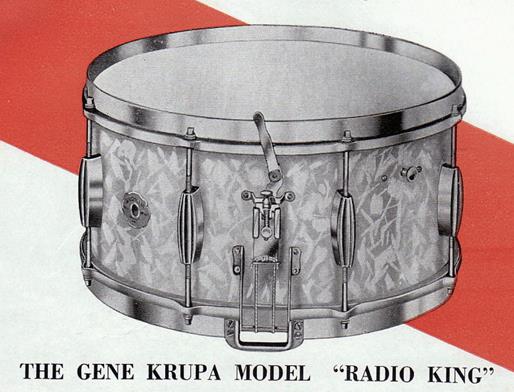


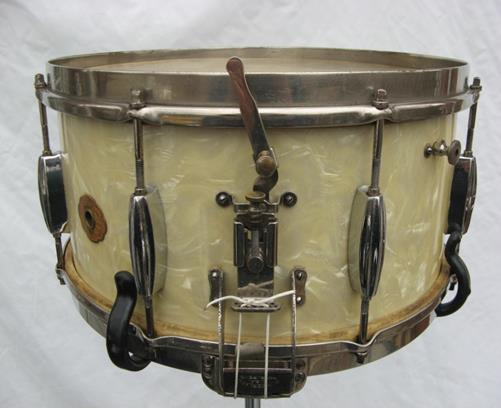
Around 1938, the adjustable
Radio King snare brackets were changed. They were made
a bit wider and now attached to the shell with six screws instead of four.
Around 1940, an optional wire strap was introduced which connected the snares
to the strainer with a small screw. These straps were offered on the Hollywood
Ace models as well as the Krupa model. The adjustable feature of the snare
brackets was gradually discontinued after 1941. NOTE: Some “top of the line”
models were offered without the extension brackets. The Buddy Rich model was
one such drum. It is also interesting to note that famous drummer Gene Krupa
was known to remove the brackets from some of his snare drums!

1937-41 Six Hole Adjustable Extension
Bracket

1940 Krupa model with
adjustable brackets and wire strap snares

“Butt” side extension bracket
without adjusting screws

The three
point strainer was made up of four basic parts: Upper knob adjustment section,
lower sliding section, throw-off lever and lever knob. Pictured below are the
various components that make up a typical early 1940’s #967 three point
strainer.

The earlier versions
(1928-1939) of the upper knob adjustment section featured a threaded “bolt”
over which the throw-off lever was fit and held in place by a threaded
(“female”) knob. The throw-off lever could be tightened either in the “up”
position while playing or “down” when not in use. This made storage easier, as
the lever extended above the top hoop when in the playing position. This design
was reversed around 1940 when the threaded bolt was replaced by a threaded hole
and the lever knob gained a threaded “male” piece which screwed into the hole.
1928-39 VERSION

1940-1962
VERSION
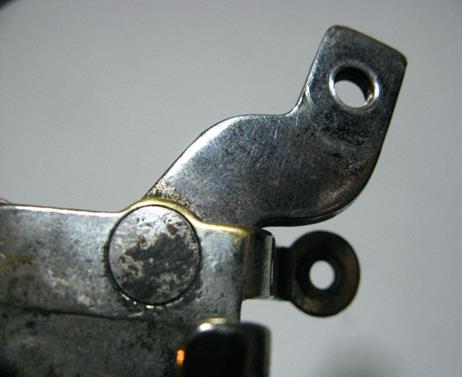
After WWII, the three point
strainer underwent subtle changes. The snare tension adjustment knob was made
larger, as was the lever knob and the shape of the lower threaded receiving
piece. These parts took on a more rounded appearance. These changes can be seen
in the photo below (The throw-off levers were removed in this photo).

Around 1963, the three point
strainer received one more major change. The previously detachable (and
retractable) throw-off lever became a part of the upper section and no longer
required an attachment knob. This eliminated the tendency for the lever and
knob to fall off. However, it could no longer be retracted or moved out of the
way. A gum rubber washer was placed below the adjustment knob. Also around this
time, the extension brackets were being made with only one screw hole on each
side.
1960’s Slingerland
Catalog showing various Radio King strainer components
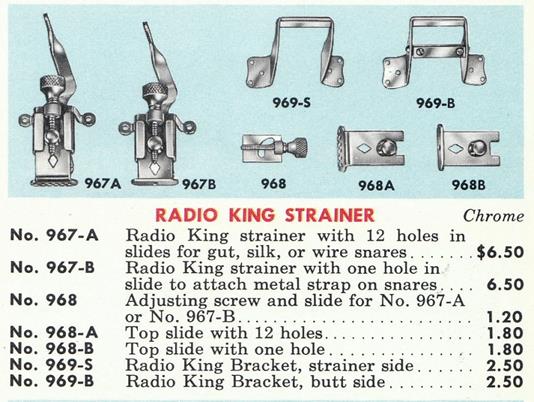

The long
running “Number 967, Speedy Sure-Grip, or Three Point Strainer” which first
appeared in 1928 would continue to be seen on the Radio King line of drums off
and on until about 1980.
1979-80 Radio King

……………………………………………………………………………………………..
![]()
THE #976 SUPER
STRAINER (1940-1962)
In 1940, Slingerland introduced a radically different snare strainer
called the “Super”. This new design allowed throw-off action from one side and
tension adjustment from the other side while maintaining constant tension on
the extended wires. When the throw-off arm was pulled to either side, the
snares would drop away from the bottom head. The strainer also featured a
telescopic “antennae”-like extension arm. The throw-off side was designated
#976, while the butt side was #977.
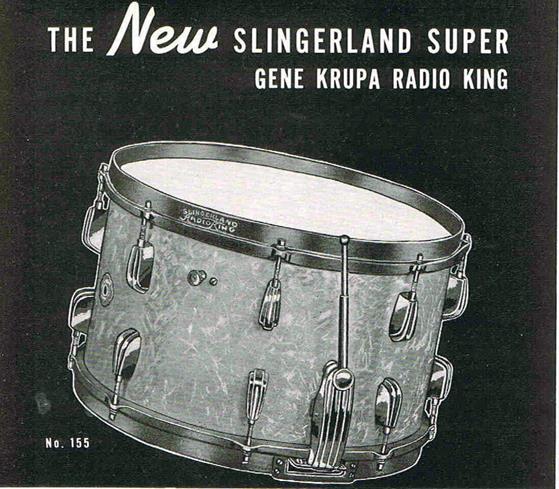
This strainer was often referred to as the “Clam Shell” due to its
artisticly designed resemblance to the shellfish. While it may have been
cosmetically pleasing and unique, the mechanical design was weak. The throw-off
arm and “clam shell” body were made from brass and prone to breakage if used
incorrectly. The earliest Super strainer (1940) allowed the snare wires to
attach by way of a metal tab, which also was susceptible to metal stress and
would snap off. Later versions used a single screw on each side to attach the
snare wires to the bottom of the strainer. There were several versions of the
Super and one major difference can be seen where the strainer body attaches to
the shell.

|
|


1940’s Super Radio
King

During World
War Two, the U.S. Government placed metal restrictions on drum manufacturers.
In answer to this restriction, the ever resourceful designers at Slingerland came up with a quite beautiful hand carved
Super strainer for their Rolling Bomber series (see the “Slingerland
History” section and also the “Drums of World War Two” page of this web site).



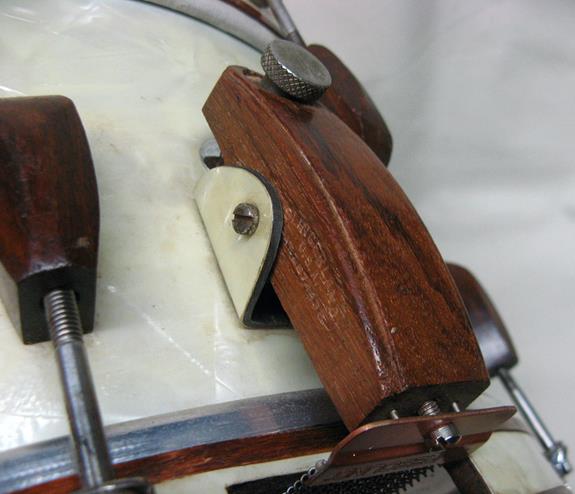

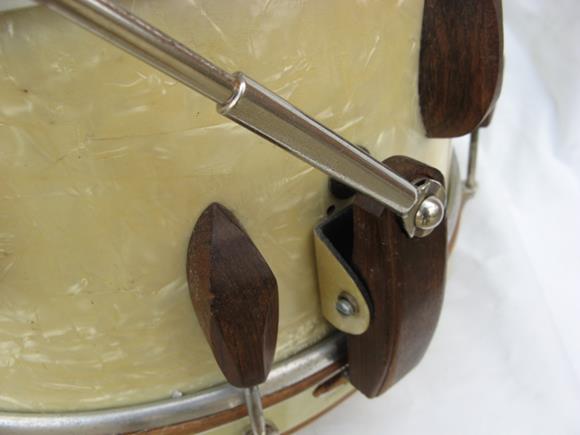

In spite of
its mechanical shortcomings, the Super Strainer was quite long lived. It was
offered as an alternative to the three point strainer until 1962. Below is a
catalog page from that year.


1958 #976/977 Super Strainer


Mid 1950’s Super Models


![]()
The Zoomatic Strainer
(1963 - Present)
The Super strainer was discontinued
around 1962 and soon a new strainer appeared on the new Artist Model snare
drums. This strainer was usually paired with a butt end plate that was
previously used on Leedy and Leedy
& Ludwig Broadway snare drums in the 1940’s and early 1950’s. The use of
this butt plate was facilitated by Slingerland’s
purchase of the Leedy line in 1956. The Zoomatic strainer also suffered from a relatively poor
design in that the adjustment knob was easily stripped if used improperly. Like
the Super strainer, the Zoomatic used special
extended snare wires.
Artist
Model with Zoomatic Strainer and Butt assembly



![]()
The
Rapid Strainer (No. 673)
The
Rapid strainer was introduced around 1958 and was offered as an alternative to
the three point strainer #967). It appeared on the Hollywood Ace and Concert
models as well as the various student and lower line models well into the
1970’s. This strainer was paired with a standard simple butt assembly. The
Rapid strainer was also used on some Slingerland-made
Leedy drums from the same era.

1960 Student Model (Top) and 1965
Hollywood Ace model (Bottom) showing two versions of the Rapid strainers
![]()

TO CONTINUE OR RETURN TO ANY OTHER SECTION IN THIS GUIDE OR TO
RETURN “HOME”, CLICK
ON A LINK BELOW…
CONTENTS:
LUGS
STRAINERS
DRUM FINISHES
MISCELLANEOUS
RETURN HOME